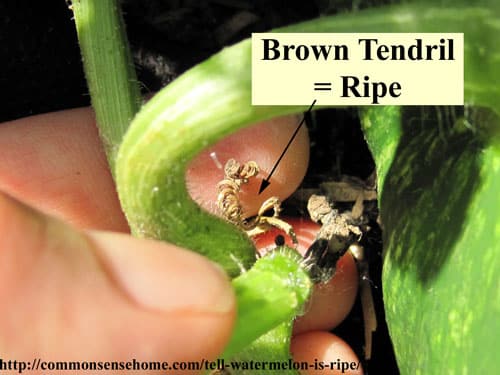Knowledgebase
How do I know when a watermelon on the vine is ripe #357691
Asked August 29, 2016, 1:42 PM EDT
Lake County Ohio
Expert Response
How to Tell if a Watermelon is Ripe
This post is primarily for those who are wondering if their homegrown watermelon is ripe and ready to pick, but most of the same tips apply for those rooting through the produce bins at the supermarket or scouting out the farmers market. Watermelons are a little sneakier than muskmelons, which slip right off the vine (i.e. come loose on their own) when ripe. Uncut watermelons are also less fragrant than muskmelons, because they don’t have that open end where the vine was formerly attached. You will never find me sniffing watermelons in the grocery store, but you may find me sniffing cantaloupes. (I do my own stunts. )
4 Clues to Tell if Your Watermelon is Ripe
Back in my late teens and early 20’s, my jobs at the family catering business included picking out the watermelons and carving the watermelon boats for parties. I was known as the resident watermelon expert, almost guaranteed to be able to pick out the perfect melon, if there was a perfect melon to be found.
Ripe Melon Tip #1 – Make Sure Your Watermelon is at Full Growth
If you’re watching the patch, you can tell when a particular melon is large, well filled out, and hasn’t changed significantly in size for some time. For first time growers, you can check the expected size on the package and weigh them if you want, but the best way to tell is to observe the growth habits of the melon.
Ripe Melon Tip #2 – Check the Little Curling Tendril Located Where the Watermelon Stem Joins the Main Vine
Right where the stem to your melon joins the main vine, there should be a little curling tendril or curly cue of vine. If this little tendril is brown and dried, odds are your melon is as ripe as it’s going to get. If the tendril is still green and springy, the melon is still growing. Sometimes all your vines may start dying back before you’ve harvested, not just a tendril. Ready or not, this is as ripe as your watermelons are going to get. Unlike some fruits, watermelons do not ripen further once they are off the vine.
Ripe Melon Tip #3 – Look at the Under Side of the Melon
The under side of the watermelon where it hits the ground should be buttery to dark yellow. If it’s as pasty white as a bald guy’s head in the middle of a Wisconsin winter, it probably hasn’t reach peak ripeness. This is a good thing to look for on purchased melons, too. Different growing conditions and different types of melons will produce a range of colors (inside and out). Much of our summer was cool and dry, less than optimal melon weather. When rain finally came, it came as a deluge, which sent the slug population skyrocketing. When I flipped over our first ripe melon, I was frustrated to find slug damage underneath. Thankfully the rind was thick and the damage didn’t go all the way though. You can see this one only has a light yellow tint. Warmer weather usually yields a darker yellow bottom.
Ripe Melon Tip #4 – Listen to the Sound
This is a classic, and the internet is filled with descriptions of what the sound should be when you thump a watermelon. Most say “flat” or “dull”. I think that’s a poor description. For my part, “flat and dull” is the sound you get when you rap on something like a giant zucchini – or an underripe watermelon. A ripe melon should have a nice, deep sound, more like a drum or knocking on a door. I did a quick video (below). My Powershot D10 doesn’t quite do it justice, but you get the general idea.
Here’s the end result. Given our uncooperative gardening season, even with the landscape fabric and other tactics to create a warmer microclimate for the melons, they didn’t get as deep red out far to the rind as I would prefer, but the flavor was still very good and they were very juicy because of recent rains. You can tell the melon is mature by the dark seeds and the cavities around the seeds.Quick Tip for Melon Storage – Don’t stick your uncut melons in the refrigerator!
Before our melons were ready, I picked one up at the grocery store that I really shouldn’t have bought. It was during our brief hot spell this summer, and the melons had obviously been stored too cold because they were chilled and sweating in the bins. Sure enough, I got it home and the flavor was bland and the texture was mushy. Melons like it warm! Room temperature storage also makes them more nutritious.











